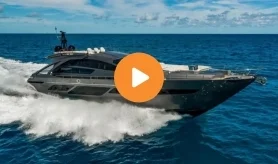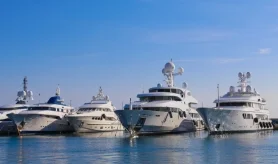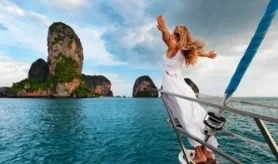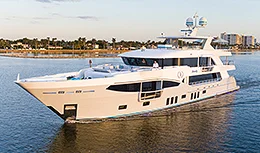- Alaskan Yachts
- Azimut Yachts
- Back Cove Yachts
- Beneteau Yachts
- Benetti Superyachts
- Bertram Yachts
- Boston Whaler
- Broward Yachts
- Buddy Davis Sportfish
- Burger Yachts
- Cabo Yachts
- Catamarans
- Carver Motoryachts
- Center Console
- Chris-Craft Yachts
- Cruisers Yachts
- DeFever Trawlers
- Dufour Sailboats
- Fairline Yachts
- Feadship Yachts
- Ferretti Yachts
- Filippetti Yachts
- Formula Yachts
- Fountaine Pajot Cats
- Grady-White
- Grand Banks Trawlers
- Hargrave Yachts
- Hatteras Yachts
- Hinckley Picnic Boats
- Horizon Yachts
- Hydra-Sports
- Intrepid Boats
- Jarrett Bay Sportfish
- Jeanneau Yachts
- Kadey-Krogen Trawlers
- Lazzara Yachts
- Lekker Boats
- Luhrs Sportfish
- Marlow Yachts
- Maritimo Yachts
- Marquis Yachts
- Mazu Yachts
- McKinna Motoryachts
- Meridian Yachts
- Midnight Express
- MJM Yachts
- Mochi Craft
- Neptunus Motoryachts
- Nordhavn Trawlers
- Nordic Tugs
- Numarine Yachts
- Ocean Alexander Yachts
- Ocean King
- Offshore Yachts
- Outer Reef
- Oyster Sailing Yachts
- Pacific Mariner Yachts
- Palmer Johnson Yachts
Fairline Phantom 50 – Boatpoint.com.au
It wasn’t until late in the day, after cruising around Port Phillip and enjoying the luxury and performance of the Phantom 50, that I discovered the aft crew cabin.
How, I asked myself, could I have possibly overlooked a cabin that features a comfortable bed, hand basin with hot and cold pressurised water and plenty of stowage space- But I guess it’s just this that typifies the subtleties and attention to detail of Fairline motorcruisers.
The crew cabin resides under the sunlounge in the aft cockpit, and the only giveaway that it exists is a small, inward-opening port on the base of the lounge. Overkill in a 50-footer- Probably, but let’s not be picky.
Fairline, curiously, has its manufacturing plant near the town of Oundle in England. Oundle is inland on the river Nene where the vessels can be floated but not tested. They have to be trucked for their extensive testing, which is done on every Fairline at Ipswich on the English coast.
Each and every Fairline vessel is sea trialled there with every facet of the boats tested and re-tested to ensure they’re perfect when delivered. Once the sea trials are completed, the boats are hauled out and completely re-detailed before being shipped to their new home ports.
Fairline was started in 1963 by Jack Newington, who was a stickler for detail and for the highest standards of excellence. This ethos has been handed down throughout the company’s 40-year history so that the standards of quality and fit and finish are tantamount to those of a luxury, hand-built motorcar – only on a far more grand scale.
This can be easily seen in the furniture and cabinetry throughout the boat. All screw heads and fastenings are concealed, and it’s obvious that much time has been spent ensuring that the doors and drawers fit perfectly.
Even the grain of the wood is uninterrupted through a whole cabinet so that the grain in the doors matches the grain of the surrounds. It’s this sort of attention to detail that endears Fairline boats to the most fastidious owners.
Construction is all handlaid unidirectional rovings, and the gel is brushed on by hand. The transom and flybridge are reinforced with aluminium for strength, and all deck fittings have big aluminium backing plates behind them.
Components like bulkheads and furniture are bonded to the hull structure, thus becoming an integral part of it and adding to the overall strength and rigidity of the boat.
Fairline boats come in three categories: the Targa, the midsized Phantom, and then the largest and most luxurious Squadron series. The 50 is the biggest of the Phantom range and offers accommodation for six people in three cabins (excluding the afore-mentioned crew quarters).
FROM THE FRONT
The owner’s stateroom forward features 6ft 4in of headroom, a huge ensuite with standing shower stall, loads of stowage including hanging robes, and a big, comfortable island bed.
There are opening ports on either side should you want fresh air rather than the individually-adjustable air conditioning – which, incidentally, is piped into the heads as well as the cabins.
Our test boat, the Sirius, was fitted out with two twin cabins aft of the master stateroom. These also have more-than-ample stowage and are serviced by a huge bathroom with full-sized shower stall.
Stepping up the four steps toward the main saloon, the galley to port once again holds some subtle surprises to make life just that little bit easier. The three-burner cooktop and microwave are obvious – but not so obvious are the clever little cupboards that make use of every bit of available space, right down to a nifty one with very little depth that is designed specifically for a cutting board.
The cutlery supplied with the boat is located in two drawers with individually-recessed pockets for each knife, fork and spoon. The Avonite benchtops are solid so that, in the event of a scratch or mark, they can be polished back to pristine condition.
To starboard is the lower helm station, which features two leather-clad adjustable seats and a fine view all around thanks to the huge picture windows.
The test boat was fitted with a full set of Raymarine navigation equipment, while the autopilot, sounder and log – as well as the dual station radio telephone incorporating an intercom between the upper and lower helms – comes standard.
All of the vessel’s electrical systems fall easily to hand from the lower helm station – and once again, due to the excellent ergonomics, the feeling of being in a European luxury sportscar is predominant.
The fly-by-wire controls for the twin Volvo D12675 EDCs are smooth and simple to operate. No catching or push-and-shove.
A well-laid-out series of rocker switches on a central console controls the main electrics, and these are easily accessed by either the skipper or the co-pilot. A lovely touch is the electrically-operated window on the starboard side, which provides fresh air to the helmsman at the touch of a button.
The main saloon is simple, sleek and elegant, with plush leather lounges and soft carpet underfoot.
Sirius has been fitted with a full home-theatre system with digital flatscreen TV and a Bose surround-sound stereo system – very impressive.
A discreet bar/cocktail cabinet resides aft of the helm station in a comfortable alcove, which is normally inhabited by the ship’s dog, we’re informed.
OUTSIDE
Through the sliding glass door astern is the large, teak-decked cockpit with sunlounge and transom door. A big swim platform with deck shower and wet storage adorns the transom.
The cockpit has hatches to the engine room and to the auxiliary room where the 7kW Onan generator lives.
Take a hike up the teak stairs to the flybridge and there’s a whole new world. Really comfy twin helm seats give access to the fully-equipped helm station. A commanding view over the wide foredeck and big forward sunlounge really lets you know this is a big boat.
To starboard of the helm seats there’s a lounge that can be converted to a third forward-facing seat if necessary.
In the middle of the flybridge there is a mini-galley with a covered barbecue, sink and fridge.
Alfresco dining can be enjoyed around the fixed table, which will seat four in comfort or six at a pinch. All this is covered by a versatile large bimini that easily adjusts for sun or shade.
Driving from the bridge would be my preference, as you’ve got everything to hand and a clear all-round view. The steering is fingertip-light and very direct, while once again the throttles are silky smooth.
OUT OF PORT
We left Melbourne’s Pier 35 on a clear day with little breeze, and as we fired up the big Volvos, the insulation and sound deadening was instantly appreciated.
Observing the five-knot limit in the Yarra, we burbled along effortlessly just off idle, chatting and enjoying the ambiance of the Phantom.
Once outside the restricted area, we eased the throttles forward and the turbos came on song with a thrust of power. The speed of the Phantom 50 is not immediately apparent. A glance at the log had me surprised that we were doing in excess of 20kt.
Smooth delivery of power and a gentle rise onto the plane belie the speed of the 17-tonne Phantom when in clear water.
Cruising effortlessly at around 26kt showed 2000rpm, and on the bridge only a slight purr could be heard from the big diesels as we knifed our way through the smooth Melbourne waters. At this speed, the Phantom 50 should use around 40lt/h, giving a theoretical range of 249nm plus a 20 per cent reserve.
We gave Sirius a good squirt and got just about 30kt indicated. At that speed, it felt stable and rock solid. Thrown into fast turns, the size was apparent – but the boat never felt unstable as it carved big arcs through the smooth Port Phillip waters.
It was unfortunate that we didn’t really get to test the rough-weather characteristics of the Phantom 50 – but I’d hazard a guess that it wouldn’t be fazed by a decent seaway.
On the way back, we set the autopilot and ambled downstairs to the lower helm station and the air-conditioned comfort of the main saloon. An icy-cold beer from the galley seemed appropriate as we eased back into port after a few hours of enjoying an absolute cracker of a Melbourne day on this fantastic motoryacht.
Our host for the day was the owner’s son, who is fortunate enough to be trusted with the keys. I asked him about the family’s plans for the boat – whether they were looking at cruising it or just using it round the bay.
“We’re thinking of taking her to Adelaide for her first cruise,” he said with an air of nonchalance. “I reckon it’d be a good cruise, don’t you-“
My oath it would… can I book the crew cabin aft-
|
Published : Sunday, 1 February 2004
SOURCE: Boatpoint.com.au



